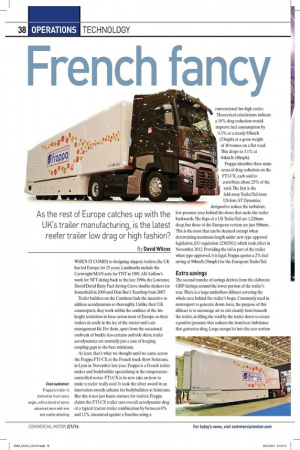Fre pch
Page 34

Page 35

If you've noticed an error in this article please click here to report it so we can fix it.
As the rest of Europe catches up with the UK's trailer manufacturing, is the latest reefer trailer low drag or high fashion? By David Wilcox
WHEN IT COMES to designing slippery trailers, the UK has led Europe for 25 years. Landmarks include the Cartwright/MAN artic for TNT in 1989, AB Airflow's work for NFT dating back to the late 1990s, the Lawrence David/David Batty Fuel-Saving Curve double-deckers for Somerfield in 2004 and Don-Bur's Teardrop from 2007.
Trailer builders on the Continent lack the incentive to address aerodynamics so thoroughly. Unlike their UK counterparts, they work within the confines of the 4m height restriction in force across most of Europe, so their trailers sit cosily in the lee of the tractor unit's airmanagement kit. For them, apart from the occasional outbreak of buckle-less curtains and side skirts, trailer aerodynamics are normally just a case of keeping coupling gaps to the bare minimum. At least, that's what we thought until we came across the Frappa FT1-CX at the French truck show Solutrans, in Lyon in November last year. Frappa is a French trailer maker and bodybuilder specialising in the temperaturecontrolled sector. FT1-CX is its new take on how to make a reefer really cool. It took the silver award in an innovation awards scheme for bodybuilders at Solutrans. But this is not just haute couture for trailers; Frappa claims the FT1-CX trailer cuts overall aerodynamic drag of a typical tractor-trailer combination by between 8% and 12%, measured against a baseline using a conventional 4m-high reefer. Theoretical calculations indicate a 10% drag reduction would improve fuel consumption by 4.3% at a steady 85km/h (53mph) at a gross weight of 40 tonnes on a flat road. This drops to 3.1% at
64km/h (40mph). Frappa identifies three main areas of drag reduction on the FT1-CX, each said to contribute about 25% of the total. The first is the fold-away TrailerTail from US firm AT Dynamics, designed to reduce the turbulent,
low-pressure area behind the doors that sucks the trailer backwards. The flaps of a US TrailerTail are 1,220mm deep, but those of the European version are just 500mm This is the most that can be deemed exempt when determining maximum length under new type approval legislation, EU regulation 1230/2012, which took effect in November 2012. Providing the tail is part of the trailer when type-approved, it is legal. Frappa quotes a 2% fuel saving at 90km/h (56mph) for the European TrailerTail. Extra savings The second tranche of savings derives from the elaborate GRP fairings around the lower portion of the trailer's rear. There is a large underfloor diffuser covering the whole area behind the trailer's bogie. Commonly used in motorsport to generate down-force, the purpose of this diffuser is to encourage air to exit cleanly from beneath the trailer, in-filling the void by the trailer doors to create a positive pressure that reduces the front/rear imbalance that generates drag. Large scoops let into the rear section
of the trailer's side skirts are designed to do a similar job, filling the void by channelling more air to exit just above the rear lamp clusters.
The third main area of drag reduction is the curved GRP moulding for the front bulkhead, even though at an overall height of 3,976mm it is well-shielded by the tractor unit. The bulkhead's forward curve extends trailer length to 14.1m on the centreline, squeezing the cab gap to minimise air ingress.
How much of that benefit would remain once a nose-mount fridge unit is installed is debatable. A combination of winning elements
A combination of other design elements contributes to the remainder of the FT1-CX's drag reduction. Side skirts not only cover the wheels but are supplemented by an air-dam moulding at the front, shrouding the electrically operated Jost landing legs. The skirts also double as hatch covers for pallet carriers beneath the chassis, so the trailer's underside is panelled in too. The body's GRP-skinned polyurethane-foam insulated
panels are radiused at the junction of the sidewalls and the roof. The body also has a subtle two-way taper at the rear, with the last 3m of the roof sloping down and the final 0.5m of the sidewalls tapering inwards just a tad. Frappa's FT1-CX is undeniably shapely and eyecatching — but would you choose to run one? According to Frappa, 50% of its drag reduction comes from the treatment at the rear, namely the TrailerTail, the underfloor diffuser and the ducted final section of the side skirts. Inevitably, these are most prone to accident damage when reversing onto loading banks or during tight manoeuvres. The mouldings around the rear lamp clusters look particularly vulnerable, even if there is an unden-un bar behind the GRP.We guess most operators would rather see a robust underrun, spring-loaded roller buffers and maybe a slight forward lean for the rear frame to afford some additional protection for the body and the TrailerTail. This trailer's accident damage costs could outweigh its fuel savings, but it would be a shame if such a stylish design foundered for the want of more practical protection where it needs it most. •












































